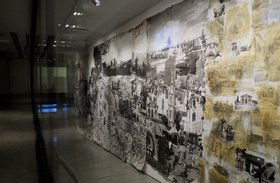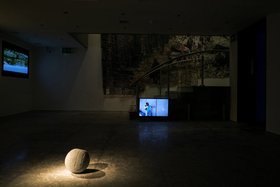Reviews
No Place Like Home
Refraction: Moving Images on Palestine at P21 Gallery
Shaheen Merali suggests that the notion of velocity underlines art. Nowhere is this truer than in the exhibition he curated at P21 Gallery, London. Titled Refraction (19th December 2012 to 16th March 2013), the show refracted perceptions, memories, representations and images of Palestine through the prism of political repression, colonisation and its woefully forgotten history. While the 'moving' in the exhibition title encompassed both the sweep of history and Merali's inclusion of film images – both feature and documentary –, a velocity appeared to be somewhat ironic considering the focus of the art was on a people and politics frozen in time, place and memory.
Opening the exhibition was Nasser Soumi's Dreams of Return (2010), a documentary encounter and interview between the artist and a Palestinian family living in Aleppo waiting until they can return to Haifa. The reminiscences of the family's grandmother, a refugee since the 1940s when her father left Haifa, dominate the footage. 'Is there anything more beautiful than Palestine?' she asks. Recalling her father's words, she swears that even the oranges and apples are bigger in their home country than any of those grown in Syria or Lebanon, where she has lived. Soumi adds an overlay of impressionistic white-out cityscapes, more than likely of Haifa, to give colour and meaning to her memories. Obsessed by homeland, the old grandmother seems to be demanding a return to Haifa and nowhere else. Yet she defies stereotypes and admits that she and her family don't mind where they go, even the West Bank, because any place in historic Palestine is better than no Palestine at all.
Other art pieces in the exhibition captured this complex history. P21 is a gallery with a focus on Middle Eastern art. In 2008 before the gallery officially opened, it commissioned kennardphillipps, a collaboration between Cat Picton Phillipps and Peter Kennard, to create Palestine. The 42 x 13 feet canvas of pigment ink, oil, paper and charcoal draws from a variety of visual sources, including archival photographs featuring important places, events, even portraiture. The giant collage is colour-coded and the yellowed beginnings symbolise the pre-1948 Mandate period onto the vivid colour of a bulldozer and the fuller tones of portraiture. Peter Kennard researched in Palestine in order to produce the work and the making of it, as captured on the kennardphilipps website. This has resulted in a piece of art that is both physically impressive and rich in historical narrative. Yet the crinkling of the canvas also suggests that not only is Palestine dated in chronological time, its importance as issue has also faded. In the refraction of the 'Arab Spring', the issue of Palestine no longer has the urgency it once had.
However, the immediacy of the unresolved issue is revitalized by the placement of the video I.Soldier (2010) by the artist Khaled Jarrar adjacent to the kennardphillipps' canvas in this exhibition. At first glance, it is not obvious to which country these soldiers in the video belong. There is the immediate impression that they could be Israeli but on closer inspection the uniformed men, marching in strict formation, wear the red berets of the Palestinian Presidential Guard. Jarrar is a captain in this unarmed militia and reveals some of the impetus behind the filming to Jerusalem's Al-Ma'mal Foundation. The observation of the training of soldiers gave him 'the opportunity to discover the weaknesses of the individuality of the soldiers that reflects itself in spontaneous behaviour that is far from any military order …' What appears like cutting satire of the IDF carries a refreshing subtext of Palestinian self-critique.
However, what dominates Israel/Palestine is the wall of spin. P21's main gallery space was filled by Lacan Palestine (2012), a 70-minute long film by Mike Hoolboom. For his sprawling epic, Hoolboom incorporates found footage, Hollywood biblical epics, savage desert terrains complete with marauding tribesmen, touchy-feely love stories and Lacanian post-structuralism, with voice-over contributions from Edward Said and music by John Coltrane. Hoolboom explores what the artist and critical theorist Elle Flanders rightly identified as 'the deep psychoanalytic rift whose symptom is contemporary Palestine.' In such a grand operatic account, the people of Palestine are faceless, obscured by a visual cornucopia in which their unique tragic national story plays only a bit part.
Overlooking Lacan Palestine, through a glass wall, was the spoof movie posters of Tarzan and Arab, two identical twins from Gaza whose artistic moniker is a riff of Tarzan and the Ape. The titles of their films advertised on their 40 x 30 inch posters take their names from Israeli military operations – Cast Lead (2012), Days of Penitence (2010) and Pillar of Cloud (2012), which is described as 'an IDF production; editing and mixing by Israel, lighting by Israel, design by Gaza, film by Gaza, assistant direction by Arab Governments and produced by the US Government' and 'written and directed by Benjamin Netanyahu'. The posters of Tarzan and Arab encapsulate the spaghetti western the Gaza Strip has become.
Humour, like post-structuralism, has become a useful tool in undermining power. However to get a firsthand sense of the deeply scarring effect of the occupation, visitors to P21 had to venture downstairs. With Laila Shawa's cross adorned with missiles Stealth Cross-Metamorphoses (2000) – the size of which wouldn't be out of place in a cathedral – and her digital print and paint on canvas Stamp for a Lost Country (2010),it would have been easy to miss Shawa's most disturbing work. A video on Blu-ray called Gaza Fashion Week (2010) was tucked away in a space behind the stairs. For the work, Shawa was able to obtain CCTV footage of a Palestinian woman being interrogated in a fenced-off pen at the Erez checkpoint on the Gaza Strip. Answering the commands of an unseen voice belonging to an Israeli soldier, she first takes off her loose jilbab coat and then unpeels other layers of clothing to prove she is not carrying weapons or a bomb. Her body shows scarring from a previous burning and as the interrogation continues for an excruciating near nineteen minutes, the young woman becomes more and more distraught. It is this queasy combination of voyeurism and militaristic fascism that makes the video so disturbing to watch.
No wonder light relief is so appreciated. P21's main downstairs gallery was dominated by the prankster Jarrar, including the six-minute absurdist video Sea Level (2012), in which the artist walks through mundane settings in Israel as a deep-sea diver unable to breathe the oxygen of his own country. Then there was his nine-kilogram cast concrete Volleyball (2012) formed out of the Israeli separation wall, which Jarrar scrapped, hammered and gouged. A video placed conveniently on the floor nearby showed the artist at work, the incessant tapping of his hammer aurally punctuates the space. An earlier incarnation of Volleyball was showcased in the 2012 Qalandiya International.
While the exhibition was filled with engrossing photography, some of this did err on the side of documentary photography, as opposed to a practice-based approach. The gallery itself contains some ambiguous presentation spaces, which require clearer sign posting. Despite these distractions, Refraction was a show with power and verve.
Palestine has been gathering force as a new Arab art territory much like Beirut did in the 2000s, even though as a political issue it has fallen down the agenda – except when there is a crisis and it's back in the news again. As curator Merali writes in the Refraction catalogue, 'we receive a more or less second by second account of invasive frenzy, of destruction and death … a succession that neither helps us analyse this intensity nor move on or move further away from this enmity.'
According to its mission statement, P21 Gallery was 'established to promote contemporary Middle Eastern and Arab identities [through] art and culture with a distinct focus on Palestine.' Owned by a group of Palestinian individuals, it has been long in the making. In the late 2000s, gallery premises on Charlton Street near the British Library in Kings Cross were obtained with funding from Sharjah, and subsequently designed by the Egyptian architect Abdul Halim Ibrahim.
Gallery director Yahya Zaloom admits that artistically and creatively there is 'common ground' between Palestine and rest of the Arab world. He believes that the emphasis of P21 does not increase nationalistic tensions but attempts to change the types of discussions about the region at large. He continues: 'We need to [make a shift] away from politics and religion and focus on contemporary artistic and cultural practices … this demands moving against the 'neo-colonialist narrative'.'
Zahloom, whose family is originally from Hebron, was born in Amman, Jordan. Like many Middle Easterners who work in the arts he has made an unusual journey, in his case from a PH.D in cancer immunology to a postgraduate MA in visual culture and citation. Through his efforts, London, a city where exhibitions are often planned two years in advance, finally has another permanent space for Middle Eastern art. To P21's credit, Refractions reflects the unresolved political and ethical problems that speak to the human cost of lives under occupation.
For more information on P21 Gallery, visit www.p21.org.uk

















